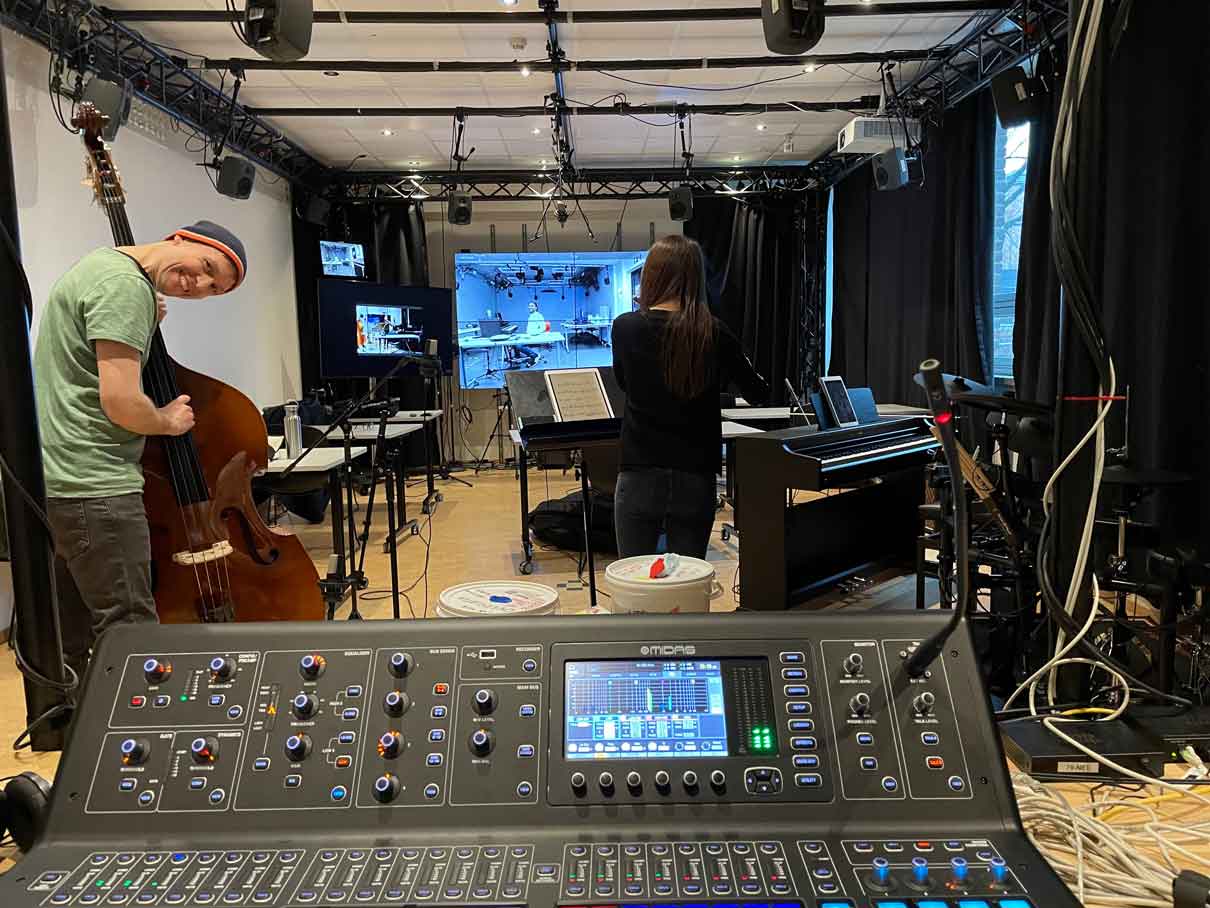Liebesgruß or we can put that 'Liebe' aside

The following section presents Joni’s reflection on Team C’s direction in Portal connection. Lindsay and Wenbo reported the setup in Trondheim and Oslo.
Trondheim’s call for love
On 24th February during the winter break, the most introverted C-team from Trondheim and Oslo creeped into the MCT Portal in the middle (not of the night) of the day. The solo Trondheim crew was able to rock the whole Portal by himself (Well-done Lindsay!).
‘’I connected the Midas M32 to Ableton live on a Windows computer, so the M32 audio interface drivers needed to be installed. At Trondheim we only have one person playing the harp on the piano as MIDI. For some reason the ceiling mics were not functional, so we used an AKG Mic as a talk-back mic to communicate with Oslo. Overall only 2 channels were being sent to Oslo via LoLa. We had problems communicating with each other at first, there were many sudden cuts and outs from the Oslo side but we managed to use discord and sort things out. Once we got the line to work with a stable connection, we focused on sending an appropriate mix to each other, more so from Oslo as they were 3 instruments with 3 mics and a lot of EQ. We recorded the session on Ableton live in Trondheim. Hey you guys there from Oslo?’’, wrote Lindsay.
Oslo’s acceptance of love
Wenbo then replied: ‘’Group C tried to connect Midas M32 to Macbook as an external audio interface and used Pro Tools for multi-track recording. Midas does not need to install drivers in the OS X environment, only needs to set DN32 as the default audio device in the audio settings of the system and DAW. At Oslo, we have three musical instruments: bass, flute and electric piano. Bass and flute are acoustic instruments, so we used two AKG C414 condenser microphones and selected cardioid direction for pickup. At the beginning, we tried to connect the piano directly to the mixer through the phone out, but considering the complexity of monitoring and recording level settings, we chose to use another microphone to pick up the sound directly. To avoid feedback noise between Oslo and Trondheim, we set EQ for each microphone. But during the rehearsal, we found that the flute’s spot microphone would have unexplainable low-frequency noise at around 80hz even when it was quiet. After eliminating the equipment problem, we used an exaggerated high-pass setting to solve this problem. In this rehearsal, we still have some doubts about the routing of the BUS track and AUX track of the mixer corresponding to the DAW. We hope to explore further in the next session.’’
Finally, we learned that the feedback issue was caused by having multiple platforms running together at the same time. In order to avoid those mysterious, unnecessary sounds, we should bear in mind that muting the right platform or bus in the mixer can do the magic. It is all about muting the right audio signal senders to the receivers and vice versa. We learned from Team B on the 1st March session - cheers Henrik!
Quick comment about the music
Musically-speaking, we should discuss more about phrasing and expression of the song. This piece was written by Edward Elgar as an engagement present to his then-wife Caroline-Alice Elgar. Therefore, besides having an ensemble with low latency, one of the most important elements to interpret this piece is timbre. In order to express the strong emotion of love, we need to understand the music and phrasing well before we can ‘talk’ about the love in different tone colours.
Nevertheless, we sight-read this for the first time and improvised alongside the performing process. Although two of us haven’t played music for some years (Joni hasn’t played for 8 years and Wenbo for 3 years), we had quite a fun rehearsal on that day.
However, there is nothing set in stone with the choice of music yet. Who knows? Although it was originally written as a ‘Liebesgruß (A loving greeting)’, it might end up as a jazzy greeting or classical greets the jazz. Feel free to share your thoughts with us if you have. :)
